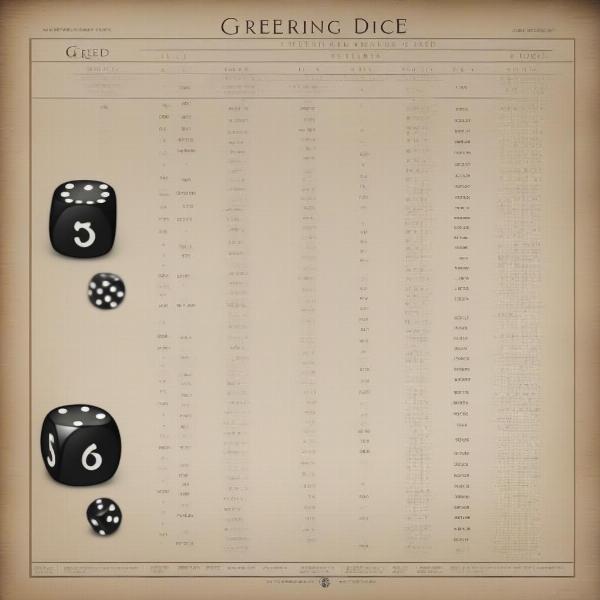Greed dice, also known as Farkle, Zilch, or 10,000, is a fun and engaging dice game played with six dice. The goal is simple: accumulate the highest score by strategically choosing scoring combinations. Learn how to play greed dice with our comprehensive guide, covering the rules, scoring, strategies, and tips to maximize your chances of winning.
Understanding the Rules of Greed Dice
The gameplay revolves around rolling six dice and selecting scoring combinations. Each turn involves rolling all six dice and setting aside any dice that form a scoring combination. You can continue rolling the remaining dice or “bank” your current score. However, if you fail to roll any scoring combinations, you “farkle” and lose all points accumulated in that turn.
Greed Dice Scoring: A Comprehensive Guide
The scoring system in greed dice can seem complex initially, but with practice, it becomes intuitive. Specific dice combinations yield different point values:
- Single 5: 50 points
- Single 1: 100 points
- Three 1s: 1000 points
- Three 2s: 200 points
- Three 3s: 300 points
- Three 4s: 400 points
- Three 5s: 500 points
- Three 6s: 600 points
- Four of a kind: 1000 points (doubles the three of a kind score)
- Five of a kind: 2000 points
- Six of a kind: 3000 points
- Straight (1-2-3-4-5-6): 1500 points
- Three Pairs: 1500 points
Remember, only combinations from a single roll count towards your score. You cannot combine dice from different rolls.
 Greed Dice Scoring Combinations Table
Greed Dice Scoring Combinations Table
Strategies to Win at Greed Dice
Winning at greed dice requires a blend of luck and strategic decision-making. Knowing when to push your luck and when to bank your points is crucial. Here are some strategies to consider:
- Prioritize High-Scoring Combinations: Always aim for combinations like three of a kind or straights to maximize your points.
- Manage Risk: Don’t get greedy! If you have a decent score, consider banking it, especially if you have few dice remaining.
- Know When to Roll: If you have several dice left with potential scoring combinations, it might be worth the risk to roll again.
- Calculate Probabilities: While greed dice involves luck, understanding the probability of rolling certain combinations can inform your decisions.
How to Play Greed Dice with Variations
While the core rules remain consistent, greed dice has several variations. Some variations introduce bonus points for specific combinations or change the scoring threshold. Exploring these variations can add a new dimension to the gameplay and challenge experienced players.
 Example of Greed Dice Gameplay
Example of Greed Dice Gameplay
What Happens When You Farkle in Greed Dice?
Farkling means you haven’t rolled any scoring combinations in a given roll. When you farkle, you lose all the points accumulated in that turn, and your turn ends.
How Many Dice Do You Use in Greed Dice?
Greed dice is played with six standard six-sided dice.
Can You Play Greed Dice Solo?
While traditionally played with multiple players, you can certainly enjoy greed dice solo. It’s a great way to practice your strategies and familiarize yourself with the scoring system.
Beyond the Basics: Advanced Greed Dice Tips
Mastering greed dice involves more than just understanding the rules. Here are some advanced tips to elevate your gameplay:
- Press Your Luck Wisely: While taking risks is part of the game, assess the potential reward against the probability of farkling.
- Adapt to the Situation: Consider the scores of other players (if any) and adjust your strategy accordingly. Sometimes, a conservative approach is better than a risky one.
- Practice Makes Perfect: The more you play, the better you’ll understand the nuances of the game and develop your own winning strategies.
“Understanding probabilities is key to winning at greed dice,” says renowned game strategist, Dr. David Miller. “Knowing the odds of rolling specific combinations allows you to make calculated risks and maximize your score.”
 Greed Dice Strategy Flowchart
Greed Dice Strategy Flowchart
Variations and House Rules in Greed Dice
Greed dice, like many popular dice games, can be customized with house rules. Some common variations include:
- Threshold to Start Scoring: Some variations require players to reach a minimum score (e.g., 500 points) before they can start banking points.
- Winning Score: The target score to win can be adjusted based on the players’ preferences. Common targets include 10,000 points.
- Bonus Points: House rules can introduce bonus points for specific combinations or achieving certain milestones.
“Greed dice is a game of calculated risks,” says experienced game designer, Sarah Connor. “Knowing when to push your luck and when to play it safe is essential for success.”
Conclusion
Greed dice, with its blend of luck and strategy, offers an exciting and engaging gaming experience. By understanding the rules, mastering the scoring system, and employing strategic decision-making, you can significantly improve your chances of winning. So, gather your dice, learn how to play greed dice, and prepare for an exhilarating game of chance and skill.
FAQ
- What happens if I roll all six dice and don’t get any scoring combinations? You farkle, losing all points accumulated in that turn.
- Can I combine dice from different rolls to create scoring combinations? No, combinations must be formed from a single roll.
- Is there a limit to how many times I can roll in a turn? No, you can continue rolling until you either bank your points or farkle.
- What is the highest possible score in a single roll? 3000 points for six of a kind.
- Can I play greed dice online? Yes, various online platforms and apps offer greed dice games.
- What are some other names for greed dice? Farkle, Zilch, and 10,000 are common alternatives.
- How many players can participate in a game of greed dice? Greed dice can be played with two or more players.

